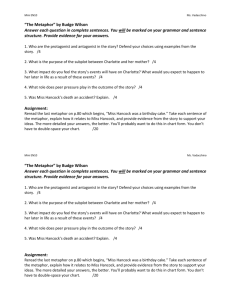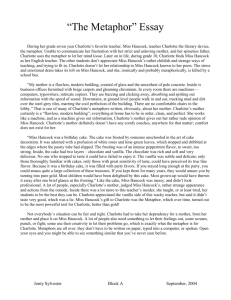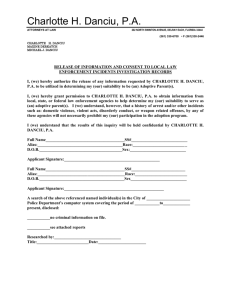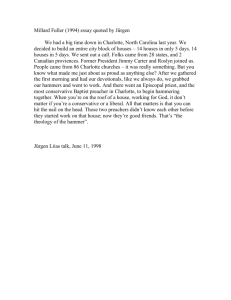Character Analysis - SD43 Teacher Sites
advertisement
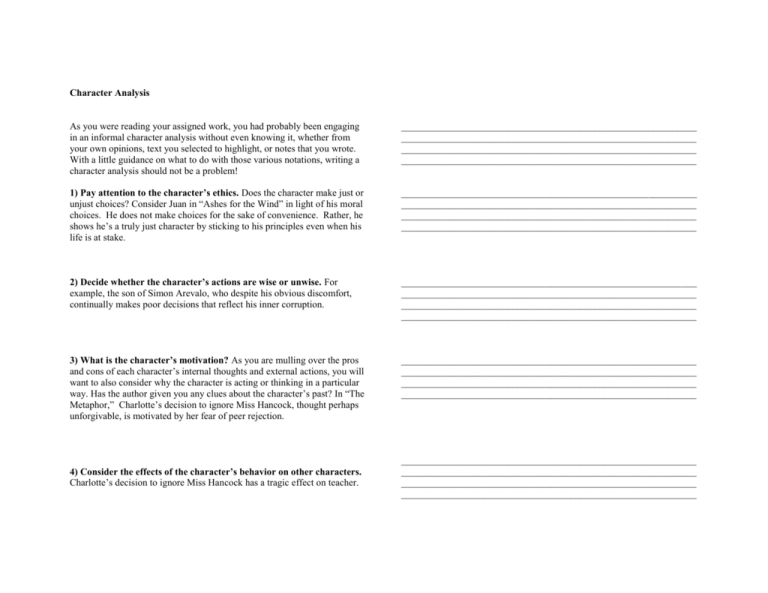
Character Analysis As you were reading your assigned work, you had probably been engaging in an informal character analysis without even knowing it, whether from your own opinions, text you selected to highlight, or notes that you wrote. With a little guidance on what to do with those various notations, writing a character analysis should not be a problem! _____________________________________________________________ _____________________________________________________________ _____________________________________________________________ _____________________________________________________________ 1) Pay attention to the character’s ethics. Does the character make just or unjust choices? Consider Juan in “Ashes for the Wind” in light of his moral choices. He does not make choices for the sake of convenience. Rather, he shows he’s a truly just character by sticking to his principles even when his life is at stake. _____________________________________________________________ _____________________________________________________________ _____________________________________________________________ _____________________________________________________________ 2) Decide whether the character’s actions are wise or unwise. For example, the son of Simon Arevalo, who despite his obvious discomfort, continually makes poor decisions that reflect his inner corruption. _____________________________________________________________ _____________________________________________________________ _____________________________________________________________ _____________________________________________________________ 3) What is the character’s motivation? As you are mulling over the pros and cons of each character’s internal thoughts and external actions, you will want to also consider why the character is acting or thinking in a particular way. Has the author given you any clues about the character’s past? In “The Metaphor,” Charlotte’s decision to ignore Miss Hancock, thought perhaps unforgivable, is motivated by her fear of peer rejection. _____________________________________________________________ _____________________________________________________________ _____________________________________________________________ _____________________________________________________________ 4) Consider the effects of the character’s behavior on other characters. Charlotte’s decision to ignore Miss Hancock has a tragic effect on teacher. _____________________________________________________________ _____________________________________________________________ _____________________________________________________________ _____________________________________________________________ 5) Look for repeatedly used words that describe the character. Those words often give insight into a character’s psychology and motivations. The son of Simon Arevalo is consistently described using words that highlight his discomfort and role as the son of an old friend. Why are these words reinforced? _____________________________________________________________ _____________________________________________________________ _____________________________________________________________ _____________________________________________________________ _____________________________________________________________ 6) Be aware of items associated with the character. They may say something about his or her state of mind. An example is the phonograph and books treasured by the old man in “The Portable Phonograph” both indicate a sense of what this character values and hoards. _____________________________________________________________ _____________________________________________________________ _____________________________________________________________ _____________________________________________________________ 7) Read between the lines. Often what a character does not say is as important as what he or she does say. When Charlotte does not respond to Miss Hancock’s lesson and plea for student response and engagement, there is much communicated about her and self-esteem. _____________________________________________________________ _____________________________________________________________ _____________________________________________________________ _____________________________________________________________ 8) Is the character “flat” or “round”? A character is considered flat (or static) when he or she does not experience change of any kind, does not grow from beginning to end. Carmen in “Ashes for the Wind” is a minor character who is limited in scope and is not developed enough for change to occur. On the other hand, Charlotte in “The Metaphor” has a powerful shift in worldview at the end of the story. _____________________________________________________________ _____________________________________________________________ _____________________________________________________________ _____________________________________________________________ 9) Consider the historical time period of the character. Refrain from making modern judgments about the past; put the character’s actions and thoughts in context. A female character living in England in the 1800s obviously could not make the choices that she could today, for both political and social reasons. _____________________________________________________________ _____________________________________________________________ _____________________________________________________________ _____________________________________________________________ 10) Finally, what does the author think? Look for any of the author’s own judgments about the characters he or she has created. The author may be directing you toward an intended interpretation. In “The Metaphor,” the author’s tone is leading us toward a harsh judgment of Charlotte’s mother. _____________________________________________________________ _____________________________________________________________ _____________________________________________________________ _____________________________________________________________
